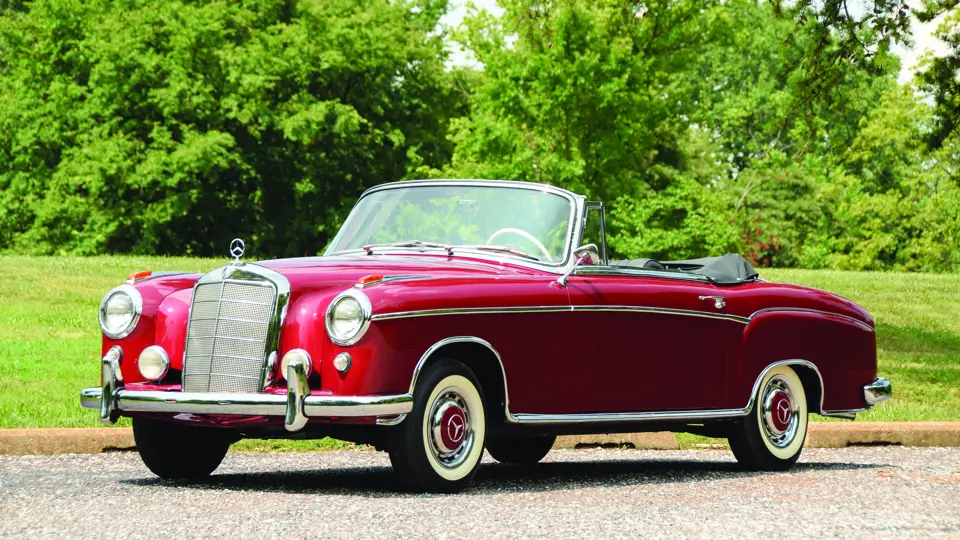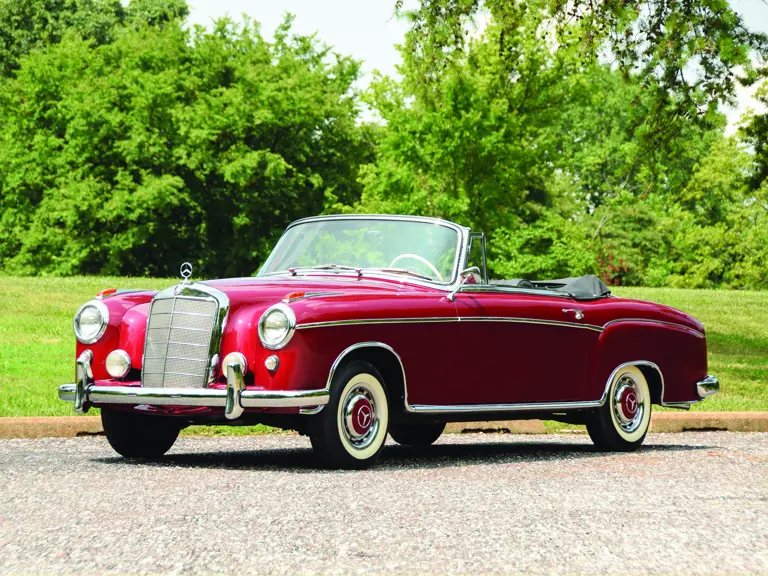
1960 Mercedes-Benz 220 SE 'Ponton' Cabriolet
{{lr.item.text}}
$126,500 USD | Sold
{{bidding.lot.reserveStatusFormatted}}
- Highly collectible for their rarity and superior quality
- Just 1,112 of these beautiful 220 SE cabriolets were built
- Older frame-off restoration which presents in gorgeous condition
- Original drivetrain and original color presentation
In the post-war period of recovery, Mercedes-Benz concentrated on re-establishing itself as a leader in the automotive industry. Their measured and focused approach earned them a reputation for building solid, reliable automobiles with exacting build quality. By the late 1950s and with their reputation comfortably intact, Mercedes-Benz could now focus their efforts on building prestige cars. Starting in 1954, a series of six-cylinder models supplanted the four-cylinder range and satisfied buyers’ requests for more power. The new Mercedes-Benz 220 models, internally designated W128, were a substantial step above the entry-level 180-Series cars. The new W128 range consisted of the 220 (1954 to 1956), the 219 (1956 to 1959), 220 S (1956 to 1959) and 220 SE (1959 to 1960) and provided abundant horsepower and torque, packaged in a moderately sized body. Of those models, only the 220 S (Super) and 220 SE (Super, Einspritzung) were available as the elegant, range-topping cabriolet.
The 220 SE coupe and cabriolet were luxuriously appointed and trimmed, offering buyers many of the same amenities associated with Mercedes-Benz’s big, limited-production 300-series cars but in a smaller, more driver-friendly package. The dash, door caps and other parts of the interior were covered in gorgeous, handcrafted woodwork. Seats and interior trim were crafted in superior Roser surface-dyed leather hides, complemented by the highest-quality Wilton wool carpets and plenty of gorgeous chrome details. The pinnacle of the W128 range was the fuel-injected 220 SE Cabriolet, introduced in 1959 and produced for just a short time frame through October 1960.
It is a pleasure to feature this ultimate W128 – a 1960 220 SE Cabriolet. This highly desirable six-cylinder, fuel-injected model has been treated to an older frame-off restoration and presents in gorgeous condition. It has seen only light use since completion and is a highly attractive and fully usable 220 SE Ponton.
Finished in its original color scheme of DB 516 Mittelrot (medium red) with 953 black leather interior and black German canvas convertible top; the quality of the paint is excellent, as is the extensive chrome plating. Fit and finish is excellent, and the panel fit is precise and consistent, a laborious task that is difficult to get right on the Ponton Mercedes; evidence this car was properly restored from the onset.
The cabin of this example features great swathes of black leather on the seats, door cards, and trim panels. Fully restored woodwork graces the dash, door caps, and door panels. It has been gorgeously finished and is certainly a highlight of the elegant interior, particularly the fantastic curved wood instrument binnacle. Lovely details abound, such as black leather door-pull straps, finely chromed details, quality switchgear, and a Becker Grand Prix AM/FM radio in the dash. A copy of the original data card is included with the sale.
The original drivetrain features a 130 horsepower, 2,195 cubic centimeter inline six-cylinder engine that runs strong thanks to Bosch mechanical fuel injection; the engine bay is very nicely detailed with correct paint finishes and plating. It shows some light use on some of the finishes, but otherwise looks very clean and beautifully presented. Power is fed through a four-speed manual transmission with a slick and easy to use column-shift.
Just 1,112 of these beautiful 220 SE cabriolets were built, making them highly collectible for their rarity as well as their superior quality. This is a car that, in period, was priced at $8,091; similar to a contemporary Cadillac Eldorado Biarritz Convertible, so it was sure to be a very exclusive automobile. For the period, this was an astronomical price as a new Rolls-Royce or Ferrari was only marginally more expensive. With the arrival of the W128, Mercedes-Benz had succeeded in regaining the prestige it had enjoyed prior to World War II. One look at this fine matching numbers example and it is easy to see how they achieved such success.


 | Auburn, Indiana
| Auburn, Indiana


